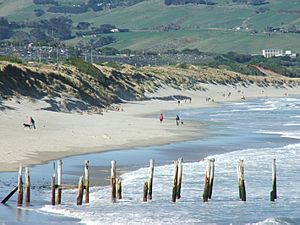St Kilda, New Zealand facts for kids
Quick facts for kids
St Kilda
|
|
|---|---|
|
Suburb
|
|

Looking east along Middle Beach and St Kilda Beach
|
|
| Country | New Zealand |
| Local authority | Dunedin |
| Area | |
| • Land | 219 ha (541 acre) |
| Population
(June 2023)
|
|
| • Total | 5,560 |
|
|
||
St Kilda is a busy suburb in the city of Dunedin, New Zealand. It's a popular place to live, located on the southern side of the city's main flat area. St Kilda is known for its beautiful beaches, St Kilda Beach and Middle Beach, which are a big part of the area. These beaches face the Pacific Ocean.
Contents
Discover St Kilda's Location
St Kilda has clear borders because it used to be its own town, called a borough, from 1875 until 1989. When it joined Dunedin City, it was the most crowded borough in New Zealand. Most of St Kilda grew between 1900 and 1930. During this time, its population jumped from about 1,500 to 8,000 people. Many of the houses you see in St Kilda today were built back then.
How St Kilda Got Its Name
The suburb was named after a place called St Kilda in Melbourne, Australia. An early property developer named George Scott, who came to New Zealand in 1862, chose the name. Before that, the area had a Māori name: Whakaherekau.
St Kilda's Past in Politics
St Kilda also gave its name to a special area for voting, called an electoral constituency. This area covered much of southern Dunedin and the Otago Peninsula. It existed from 1946 to 1993 and was represented by several important politicians.
Nearby Areas and Main Roads
St Kilda is surrounded by other suburbs like St Clair, Forbury, Caversham, South Dunedin, Musselburgh, and Tainui. Some of the main streets in St Kilda include Prince Albert Road, where you'll find most of the shops. Other important roads are Queens Drive, Richardson Street, and Victoria Road. Victoria Road runs along the southern coast, separated from the ocean by large sand dunes. You can find the Sir James Barnes Memorial Lookout near the highest point of these dunes. From there, you get amazing views of St Kilda and the surrounding city.
Fun Things to Do in St Kilda
The streets in St Kilda are mostly in a grid pattern. However, there's a long curved road called Hargest Crescent. This road follows the old boundary of Forbury Park, which is a famous horse racing track. The park was made smaller in 1909.
Sports and Recreation Spots
St Kilda is home to the Dunedin Ice Stadium, which has an Olympic-sized ice-skating rink. There are also several sports fields, including De Carle Park, Marlow Park, Kettle Park, and Hancock Park. Part of the Chisholm Park Golf Course is also in St Kilda. The suburb has three pubs, a bowling green, tennis courts, and a badminton hall. While there are no high schools directly in St Kilda, King's High School (for boys) and Queen's High School (for girls) are very close by.
Local Clubs and Businesses
St Kilda is a hub for many community groups. It's home to the St Kilda Sentinel Brass Band, the Pirates Rugby Club, and the Otago Model Engineering Society. You can also find the Ocean Beach Railway, the St Kilda Surf Lifesaving Club, a Hot Rod Club, and the Ocean Beach scout group here. Since St Kilda is mostly a residential area, there aren't many big industries. One exception is Wests, a company that makes soft drinks, located on Bay View Road.
St Kilda's Community: Who Lives Here?
St Kilda covers about 2.19 square kilometers. As of 2023, it has an estimated population of about 5,502 people. This means there are around 2,512 people living per square kilometer.
Population Changes Over Time
The population of St Kilda has changed a bit over the years:
- In 2006, there were 5,259 people.
- In 2013, the population was 5,298.
- By 2018, it had grown to 5,502 people.
A Look at the People in St Kilda
In 2018, there were 5,502 people living in St Kilda across 2,328 households. There were more females (2,910) than males (2,586). About 984 people (17.9%) were under 15 years old. The largest age group was 30 to 64 years old, making up 42.0% of the population.
Most people in St Kilda (84.3%) are of European/Pākehā background. Other groups include Māori (12.0%), Pasifika (5.6%), and Asian (7.0%). Some people identify with more than one ethnic group. About 17.6% of the people in St Kilda were born overseas.
When it comes to religion, many people (54.2%) said they had no religion. About 33.5% were Christian. Smaller numbers followed other religions like Hindu, Muslim, and Buddhist.
For those aged 15 and older, about 18.7% had a university degree or higher. About 43.7% of people aged 15 and over worked full-time, and 13.3% worked part-time.
St Kilda's Past Leaders
Since St Kilda was its own borough from 1875 to 1989, it had its own mayors. These mayors were important leaders for the community during that time.



